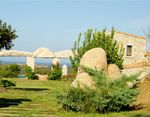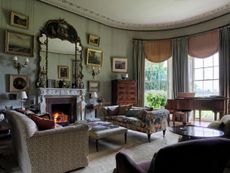Buying property in Sardinia
Carla Passino takes a closer look at Italy's best-kept secret - property for sale on the beautiful island of Sardinia

Cobalt waters lap dunes of golden sand capped with tufts of gorse, lavender and myrtle in Piscinas, on Sardinia's western shores. On the opposite side of the island, fierce waves the colour of wine crash against limestone cliffs, and, further north, a deep turquoise sea washes against a pale pink beach strewn with fragments of coral and shells.
Sardinia's coastline is so magical that it has prompted some historians to identify it with Scheria, the mythical land of the Phaeacians in Homer's Odyssey. Whether or not it was really the idyllic home of Princess Nausikaa and King Alkinoos, Sardinia made a lasting impression on the ancient Greeks, who named it the island of the silver veins, and has been attracting interest from foreigners ever since.
Often, it was the wrong kind of interest. Sardinia has known a tumultuous history of invasions. Carthaginians, Romans, Vandals, Saracens, Aragonese, Spaniards and pirates of every faith and colour sought to conquer the island or ravage its coasts. Such a troubled past, coupled with centuries of under-population, accounts for the paucity of period houses along the seashore. With the exception of a few fortified strongholds and cliff-top villages, residential development along Sardinia's coasts mostly took place in the second half of the 20th century, well after the invaders of yore had given way to a new breed of altogether more friendly foreigners-travellers and second-home buyers.
The first impulse to develop the Sardinian shoreline came from His Highness The Aga Khan IV, who fell in love with an enchanting stretch of beaches and hillsides that he named Costa Smeralda. The area was an instant hit with both the Italian and the international jet set. Actors such as Vittorio Gassman, Catherine Deneuve, and Brigitte Bardot, industrial tycoons such as Gianni Agnelli and Aristotle Onassis, and even kings (Juan Carlos I of Spain) turned the area into the summer setting for their dolce vita. Fifty years (and an airport) later, the coast remains hugely popular, drawing anyone from fashion designer Roberto Cavalli to Italy's prime minister Silvio Berlusconi, who spends part of his time at the gigantic Villa Certosa in Porto Rotondo.
‘When people think of Sardinia, they think of Costa Smeralda, even if they don't know where exactly it is,' says Rupert Fawcett of Knight Frank. The local architecture is undeniably unobtrusive (no electricity or phone cables, or advertising bill-boards are visible anywhere). ‘Each house is recognised as being by a specific architect, and the strictness of planning measures has made the coast what it is,' explains Mr Fawcett. The area's hectic social life may not be everyone's cup of tea, but those who wish it can easily lead a low-key life, and still get to enjoy the exceptional sailing and the jaw-dropping seascape.
Even though sales were ‘very low' in the past couple of years and people are ‘no longer paying silly money,' according to Mr Fawcett, ‘confidence has come back to the market' and values remain on the dizzying side. This is partly thanks to an influx of extremely wealthy buyers from the former Soviet bloc. The Russians ‘are scrambling to purchase the relatively few seafront villas at any price,' according to Savills' associate Lawrence Camillo, who knows of a house that exchanged hands for €120 million.
Giancarlo Bracco of Christie's International Real Estate's associate Immobilsarda says that ‘prestigious waterside villas in Porto Cervo or Porto Rotondo start from €30 million. Elsewhere, they can range from €2 million to €20 million'. Second-row homes are more affordable, but by no means cheap. In the highly sought-after area of Romazzino, says Mr Camillo, ‘they've jumped from €6 million last year to €10 million this year.' Even apartments in key locations-which are becoming increasingly popular, according to Gemma Bruce of Aylesford International-cost around €1 million.
Sign up for the Country Life Newsletter
Exquisite houses, the beauty of Nature, and how to get the most from your life, straight to your inbox.
Partly because of these extraordinary prices, Costa Smeralda today is mostly the preserve of a few, very wealthy foreigners and mainland Italians. Local buyers, and anyone else without a multimillionaire budget, tend to flock to other destinations, either on the Costa Paradiso-a stretch of coastline a couple of bays north of Costa Smeralda that's popular both for its extraordinary seascape and for the great selection of properties at reasonable prices, according to Linda Travella of Casa Travella estate agents-or closer to the island's two main cities, Cagliari, and Sassari.
Although long established among Italian buyers, these markets are only just opening to international business. ‘It may be a while before we see real interest outside of Smeralda, but the rest of Sardinia will certainly become more of an international destination,' says Mr Fawcett.
In the south of the island, many of the oldest and most established resorts are scattered either side of Cagliari. Old, of course, is a relative term, as most of them were developed in the 1960s and 1970s, even though some of the villages had ancient origins. The landscape here is more visibly built than in Costa Smeralda, and not to the same standard, but the seascape is just as amazing in Villasimius, east of Cagliari. Beaches are either expanses of white sand, or tiny coves peppered with craggy outcrops -or both, like Punta Is Molentis, which has a sandy beach on one side and a jagged shore of granite boulders on the other.
Properties of every shape and size are scattered all along the Villasimius promontory. The prettiest ones are small villas built to mesh in with their surroundings. They make ample use of stone and tiles and echo the natural ochre, cream and olive green of the southern Sardinian countryside, with clambering vines of fuchsia or bougainvillea providing a dash of colour. Prices are low compared to Costa Smeralda they range from €2,300 to €5,400 per square metre, according to Italian estate agents Tecnocasa.
Values are roughly the same in Pula, Santa Margherita di Pula and Chia, three resorts on the opposite side of Cagliari's wide gulf. Sandwiched between the Mediterranean and the holm-oak forest of Is Cannoneris, this was once the pulsating heart of Sardinia, home to one of the region's most important Roman cities, Nora. Today, honey-coloured ruins and the later remnants of Spanish fortresses add a touch of magic and people can boat or swim by the crumbling Roman baths. The waters, which run the gamut from palest blue to deep emerald, are home to starfish, sea urchins and, occasionally, sea turtles. In Chia's Su Giudeu beach, dunes of rich gold sand separate the sea from a sapphire-blue lagoon populated by flamingos.
The housing stock is as diverse as the scenery. Chia has a range of villas of different sizes on the hillsides overlooking its six beaches. Santa Margherita, one of the earliest and most upmarket resorts to be developed in the southern portion of the island, has large villas set in dense pine woodland bordering a 2½-mile long beach.
Pula also has a range of modern waterside villas, and the Sardinian planning authority has just given the go ahead to a (previously stalled) project to develop 240 luxurious villas designed by leading Italian architect Massimiliano Fuksas, set in parkland around the Is Molas golf club. They will be priced from €1.3 million and ready for a 2013 delivery (through Immobilsarda, 00 39 0789 909000).
But the 19th-century centre of Pula is also one of the few places where you can find period homes very close to the shore. Among them are some large case campidanesi, traditional southern Sardinian houses built around a Roman plan, with a large central courtyard giving access to all the main rooms. Many have now been adapted to modern living with passageways linking room to room, and are incredibly popular.
Another place where you can find period houses by the shore is the north-western coastline close to Sassari, Sardinia's second-largest city. Just south of Sassari, the town of Alghero was one of the Aragonese strongholds in Sardinia and, later a Spanish one. Today, battlements rise above a wide cove and its pretty harbour, encircling the medieval palazzos and graceful churches of the historic centre.
Buyers tend to cluster in the Lido area, which stretches behind the long, white beach of the same name that overlooks the old city. ‘Clients generally want a place close to but not in town,' says Mrs Travella. Properties for sale in the Lido range from modern apartment complexes to large contemporary mansions with prices in the region of €2,300 to €5,000 per square metre depending on location and condition.
More exclusive than Alghero is Stintino, a late-19th-century fishing village in Sar-dinia's north-westernmost tip, just opposite the islet of L'Asinara. ‘Alghero and Stintino have an increasingly international presence-in the past, it was mostly Italian,' says Beatrice Sidoli of Winkworth Italy. Properties for sale are few, but you can find a handful of flats in old village houses, a range of new developments in the area of Cala Lupo and a few villas close to the extraordinary beach of La Pelosa. Prices range from €2,600 to €5,000 per square metre.
The market for second homes inland remains very limited, however, change is slowly afoot, particularly in the Gallura countryside, which borders the Costa Smeralda. ‘We are beginning to see a bit of interest on the outskirts of the Costa Smeralda because it's still close to the coast, but prices are much cheaper,' says Mr Fawcett.
Among the most sought-after properties in the area are the stazzi, local stone farmhouses that are rarely more than one storey high. ‘We are seeing a new market for agricultural estates with stazzi in need of restoration, as well as a recent interest in 1950s-1970s properties in villages such as Tempio Pausania, Berchidda, Monti and Luras,' say local agents Antonello and Giampiero Demuro of Live in Sardinia.
Stazzi are dotted throughout Gallura, but a particularly lovely area to look in is the village of Luras, which stands on a granite hill above a manmade lake. The countryside around it is carpeted with Nebbiolo and Vermentino vineyards (inc-luding the excellent Cantina Depperu winery). Houses for sale here are few and far between, but they are extremely affordable-a 400sq m period villa in the centre of Luras is on the market for €450,000 (available through Live in Sardinia, 00 39 345 345 4394).
-
 Brockfield Hall, the great Yorkshire house that's gone from Regency mansion to modern family home
Brockfield Hall, the great Yorkshire house that's gone from Regency mansion to modern family homeBrockfield Hall in North Yorkshire is the family home of Charlie Wood and Hatta Byng, editor of House & Garden, who have transformed it since they came here in 2020, winning multiple awards in the process. John Martin Robinson reports on the restoration project that revived this compact Regency house as a modern family home. Photographs by Paul Highnam for Country Life.
By John Martin Robinson Published
-
 Barbour’s heritage jackets get a floral makeover courtesy of Erdem
Barbour’s heritage jackets get a floral makeover courtesy of ErdemUtilitarian outwear has taken the fashion world by storm and now Britain's world-famous wax jackets are getting in on the act, inspired by some of our greatest countryside icons.
By Amy de la Haye Published
